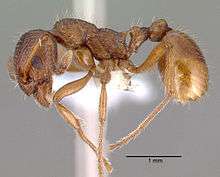Myrmica rubra
Myrmica rubra, also known as the European fire ant or common red ant, is a species of ant of the genus Myrmica, found all over Europe and is now invasive in some parts of North America[1] and Asia.[2] It is mainly red in colour, with slightly darker pigmentation on the head. These ants live under stones and fallen trees, and in soil. They are aggressive, often attacking rather than running away, and are equipped with a sting, though they lack the ability to spray formic acid like the genus Formica.[3]
| Myrmica rubra | |
|---|---|
 | |
| worker | |
| Scientific classification | |
| Kingdom: | |
| Phylum: | |
| Class: | |
| Order: | |
| Family: | |
| Subfamily: | |
| Tribe: | |
| Genus: | |
| Species: | M. rubra |
| Binomial name | |
| Myrmica rubra | |
This species is very similar to M. ruginodis, but M. rubra is the commoner of the two.
The larvae of the butterflies Phengaris alcon (Alcon blue) and P. teleius (scarce large blue) use M. rubra as their primary host.[2]
Distribution and habitat
This is one of the most common and widespread Myrmica species of the Palaearctic. It occurs in the region stretching from Portugal to East Siberia (as far as Transbaikalia), and from northern Greece to the forest-tundra zone in the North.[4] It is also colonizing Japan and North America, where it is considered a nuisance and an invasive species.
These ants are very common in Europe and live in meadows and gardens. They live on a diet of honeydew excreted by aphids and feed on many types of insect and other invertebrates. They will attack any creature that disturbs their nest, but are not as aggressive as the red imported fire ant. They also consume pollen, a phenomenon rarely documented in ants of the temperate zone.[5]
Behavior
This ant's colonies have a polygyne form and can include up to one hundred queens per nest.[6] These queens will have gathered together after their nuptial flight, formed a nest and laid their eggs in it. The species is also polydomous, with many nest sites per individual colony.[2] The queens can live up to fifteen years. Nuptial flights take place normally in late July to mid-August in Europe. Hundreds of young queens and males take to the air to mate together. Afterwards, the males die and the queens shed their wings to make a new colony. No nuptial flights have been witnessed yet from this species where it is living in North America,[2] however male-only mating swarms have been recorded in Newfoundland, Canada.[7]
The ants explore the surrounding area around their nest and look for materials, both plant and animal, to feed their colonies. When they find dead bodies, undertakers pick up the dead bodies and quickly carry them away from their nest up to 3 metres (9.8 ft) away. They choose locations randomly, and so this species does not create cemeteries.[8]
References
- "Myrmecol. News 14: 87-96". myrmecologicalnews.org. Retrieved 2019-03-14.
- "European fire ant". Featured Creatures. University of Florida/Institute of Food and Agricultural Sciences. Retrieved 2008-06-25.
- "Myrmica rubra (insect)". issg.org. Retrieved 2008-06-25.
- Czekes Z, et al. (2012). "The genus Myrmica Latreille, 1804 (Hymenoptera: Formicidae) in Romania: distribution of species and key for their identification" (PDF). Entomologica Romanica. 17: 29–50.
- Czechowski W, et al. (2011). "Rubbish dumps reveal the diet of ant colonies: Myrmica schencki Em. and Myrmica rubra (L.) (Hymenoptera: Formicidae) as facultative pollen-eaters" (PDF). Polish Journal of Ecology. 56: 737–741.
- "Species of ant". antnest.co.uk. Archived from the original on 2008-07-05. Retrieved 2008-06-25.
- "Myrmecol. News 16: 31-34". myrmecologicalnews.org. Retrieved 2019-03-14.
- Diez, Lise; Deneubourg, Jean-Louis; Detrain, Claire (October 2012). "Social prophylaxis through distant corpse removal in ants". Naturwissenschaften. 99 (10): 833–842. doi:10.1007/s00114-012-0965-6. ISSN 0028-1042. PMID 22955492.
External links
| Wikimedia Commons has media related to Myrmica rubra. |
- Ant wiki information on Myrmica rubra.
- Brief report from the University of Maine on the management of Myrmica rubra in the U.S., with extensive additional references